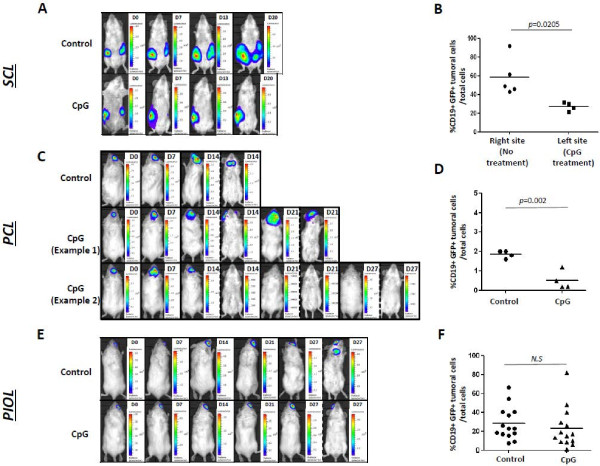Figure 2.
CpG-ODNs decrease the burden of subcutaneous and cerebral tumors but fail to induce PIOL regression. The 2-tumor-site SCL model: (A) Representative bioluminescence images of SCL treated with control ODNs (upper panel) and CpG-ODNs (lower panel). The mice were injected with 5x106 A20.IIA-GFP-luc2 cells. Treatment was injected in situ when the tumor reached 0.5 to 0.7 cm in diameter. (B) Flow cytometric analysis of GFP+ CD19+ tumor cells, 7 days after the end of CpG-ODN administration in right tumors compared to left (untreated) tumors. PCL lymphoma model: (C) Representative bioluminescence images of PCL mice treated with control ODNs (upper panel) and CpG-ODNs (both lower panels), showing 2 different profiles of responsiveness to CpG motifs. The mice were injected with 5x104 A20.IIA-GFP-luc2 cells and treated one week after tumor inoculation. (D) The percentage of CD19+ GFP+ tumor cells, as determined by flow cytometry, in the brain of mice treated with CpG at 60 μg/2μL, in comparison with PBS 1X (Control)-injected mice (n = 5 per group). PIOL lymphoma model: (E) Representative bioluminescence images of PIOL mice treated with control ODNs (upper panel) and CpG-ODNs (lower panel). The mice were injected with 104 A20.IIA-GFP-luc2 cells. CpG-ODN treatment was administered on day 0 intravitreously. (F) Flow cytometric analysis of the percentage of GFP+CD19+ tumor cells in PIOL-inoculated right eyes (n = 14 per group). A week after tumor injection, right eyes of mice were treated intravitreally by 20 μg/2 μL of mice injected with CpG-ODNs or PBS 1X (Control). Results obtained from 2 independent experiments were pooled. Statistical test: Mann–Whitney; NS: not significant.

